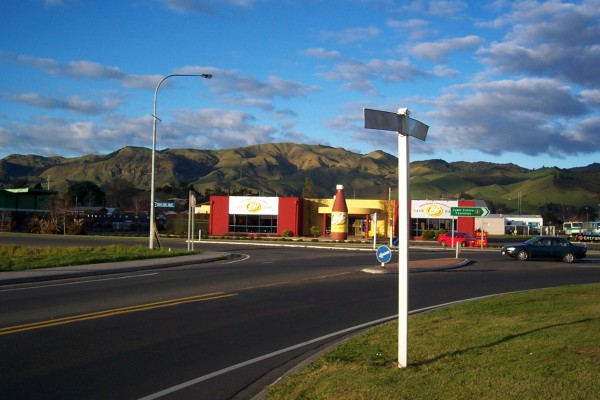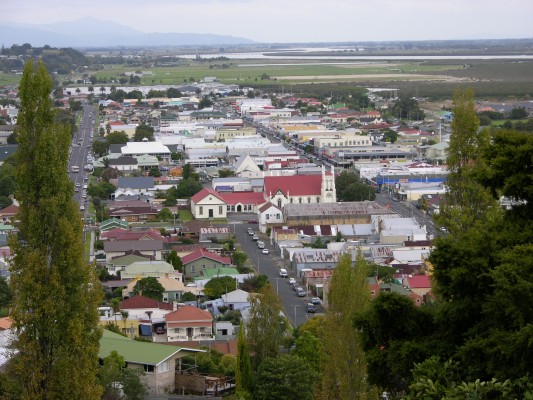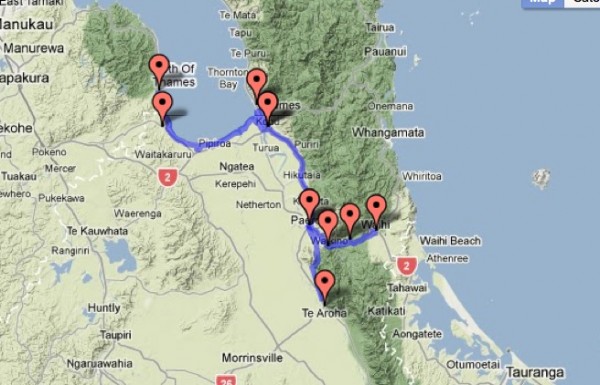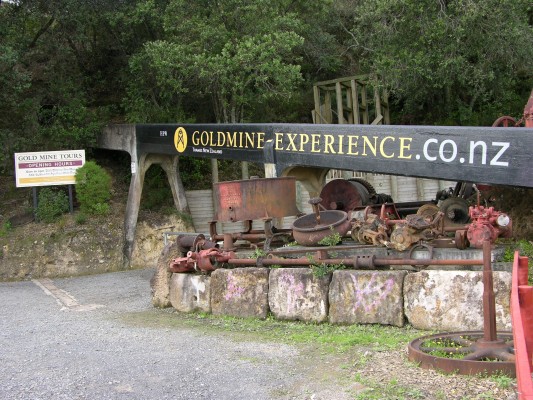Thames Line Handed To Cycleway
The idea of cyclists using the old Thames rail link as a cycleway has taken a big step forward.
The Hauraki Council has secured a 20 year lease on the line from KiwiRail - although KiwiRail has the option to take it back at anytime it decides to run trains there again.
In September the council began negotiations with KiwiRail to secure the lease of the rail corridor as defined in the route of the Hauraki Rail Trail.
Farmers objected at the cycleway crossing their land. Some 54 farmers have individual KiwiRail leases. These leases will be terminated and a single lease issued to Council.
The 73k stage one uses the old rail corridors running from Paeroa to Thames, and from Paeroa through the Karangahake Gorge to Waihi. The line consists of: Thames to Paeroa 33km; Paeroa to Waihi 20km and Paeroa to Te Aroha 20km.
The use of the railway corridor allows for a flat, wide and smooth trail, for those riders wanting an easy gradient or experience - so the trail, part of the NZ Cycleway plan, will be a grade 1 ride. It’s hoped that trail’s easy gradient and close proximity to Auckland, Hamilton and Tauranga will make it very popular - the North Island equivalent of the South’s Central Otago rail ride.
The majority of the track will be suitable for wheelchairs and pushchairs, with access points provided for these. Horses and motorbikes are banned. Stage 2 of the proposed cycle trail will be a leg from Kaiaua to Thames. This work will be planned for after the completion of stage 1. Eventually there is also talk of letting cyclists use the old Kopu bridge.
The council says negotiations have concluded and a lease, suitable to the council and KiwiRail has now been secured with these terms:
- The term of lease is 20 years
- Annual rent is $31,700 reviewable annually
- Total value of the lease over the 20 year term is $632,700
- Public Liability Insurance required was $2m
- The lessee has to maintain all fencing, and be responsible for the whole ‘rail corridor’
- KiwiRail can terminate the lease giving a minimum of 2 years notice.
KiwiRail says the Hauraki cycleway is likely to be used as a model for future initiatives.
The cycleway trail’s project manager Garry Towler says that despite taking much longer than anticipated a ‘workable’ lease has been secured. Once the
farmers have been served termination notices (generally one month, in some cases three) access to some parts of the rail corridor is possible.
It was anticipated that lease termination will coincide with resource consent approval, which would ensure unencumbered access to the rail corridor, to commence construction.
He said the sign off meant that construction was now “that much closer.”
The main trail will be 3-day ride, but the trail route will include multiple access points offering a range of shorter riding options including day rides.
The project has been given $4m from the Government cycleway fund. Key tourism attractions will include: The towns of Thames and Paeroa - the home of the World famous L&P bottle; the gold mining town of Waihi and its nearby white sandy beaches, old mining infrastructure such as the Victoria battery, the Blackpool Dam and Water Race, and the Waihi-Waikino vintage railway, the Te Aroha Mineral Spas and the Te Aroha Leisure Pools.
The Matamata-Piako District Council says the cycleway is expected to bring between 45-60,000 visitors each year into the Thames Coromandel, Hauraki and Matamata-Piako Districts, benefiting the communities by up to $16 million each year once all stages are complete.
The trail will also open up new business opportunities ranging from bike hire, to accommodation, tours, transport and more.















19 Comments
[...] Auckland Trains is a post with great news about the Hauraki Rail Trail. It looks like it is going to get [...]
Dissapointing. I love cycling but once this happens there will be ZERO CHANCE that trains will ever run over this route again. Not particulary great medium to long term vision in the face of the cost of crude oil etc.
@Martin, the lease arrangement gives KiwiRail the right to reuse the corridor for rail purposes in future. The land remains a designated rail corridor, so the ability to run trains again one day is unaffected.
Very unlikely trains would ever run here again anyway. So may as well make it into a cycleway.
Even if the land is still designated for rail I think it would be extremely hard to ever put a rail like in here again as the costs would probably be to high.
Yeah sure out its unlikely that tracks will ever be related but thats not because of this being a cycle way, but because they lifted the tracks in 1997. It’s a shame the karangahake section wasnt left because that would be a world class scenic train line
The Karangahake section was mostly lifted very soon after the Kaimai tunnel opened as it was the old east coast mainline.
But yeah, I agree. It would have been nice to have a tourist train running right through from Waihi to Paeroa, or better still from Paeroa to Tauranga.
Cool.
Good news. I imagine the Karangahake section will go to Waikino where the heritage train runs to Waihi - hopefully cyclists will be able to put their bikes on the train if they don’t want to ride the road into Waihi.
If the Kaiaua - Thames section is completed, this will provide cycletourists with a good way of leaving/getting to Auckland - the route through Clevedon and Kawakawa around the Firth of Thames to Miranda is very pleasant, but an off road route across the plains to Kopu would be good.
I notice the image of the the L&P bottle is the fake at the north end of Paeroa - the real one is at the south end of town
This is all good as this line will never reopen, but it is a ghastly precedent for the Northland and Gisborne Lines…. once the tracks are up it’s all over.
One thing that maybe overlooked here is that the Waihou river is navigatable from Kopu or even Thames for that matter to Te Aroha so there is the opportunity for an operator on the river so bike one way and canoe or ferry the other.The other opportunity is the section from Waitoa to Te Aroha the bridge over the river is still in place. Waitoa is the present day terminus for the rail network. Anyway not to difficult to lay track and have some kind of train connecting to the mainline at Morrinsville. It would have potential if Auck Tauranga or Auckland Roturua services were ever reinstated. At the Waihi end of course the roadbed of the old track to Apata is still largely in existance although it is in Private hands. However if our cyclist could negotiate public roads to Athenree or Bowen Town then a ferry to Tauranga and Mount Maunganui comes in to play. A trip down the harbour can be a very pleasant experience on a nice day. Of course a ferry from Auckland to Corremandal would provide a great springboard for our cyclist to get out of Auckland. Better than negotiating the Great South road.
As a dedicated and active advocate for sustainable transport initiatives, I will never support the removal of long term strategically essential alternative transport infrastructure to make way for short term recreational needs.
A government that encourages and enables this to happen is not only irresponsible but is also dangerous.
That KiwiRail have the right to take the rail corridor back to re-lay the tracks in the future does nothing towards achieving the goal we should all be working toward, of reducing our carbon emissions and our dependence on increasingly expensive imported - or even locally produced - fossil fuels.
New Zealanders have been conned by the National government into accepting the bait of cycleways in place of ‘uneconomic’ railways in order to reciprocate to their benefactors in the auto-petro-lobby who got them into power by ensuring that they can operate in a competition free environment.
How much space do recreational cyclists actually need ? I’ve ridden beside railway tracks all over the world. Why can’t cycleways be built alongside tracks within the rail corridor ?
Your off your nut mate…….this is an excellent initiative….these lines are never going to be relaid…not by National…not by any other political party….instead of the land that the corridor sitting idle it will be used constructively for the benefit of the locals in the area……
Be grateful that the Government is making the best of a bad situation..pumping money into KR and forcing it to run as a commercially sustainable business. I would love to see all lines remain open sure…but I just know that it isnt going to happen…
Agree with Buffalo Bob on this one - although you could be more polite about it.
Rails to trails are developed around the world and when a rail line is no longer used this is the best use for them - rather than their total destruction into unproductive use. The pity is that up until the late 1980′s abandoned rail corridors in this country were sold off - that was a disgrace and vandalism of its worst kind. Imagine some of the wonderful rail trails for walking / cycling that could have been used if that had not been done eg. Roxburgh line, Nelson line, Farilie line, Catlins River Line, Tuatapere line etc etc. It is a great way to preserve the corridor for more productive use once rail is no longer relevant in a particular area and respectful to men and woman who toiled so much in building them. Having rail for rail sakes just because tracks are there undermines the viability of the rest of the viable network. If the corridors are ever needed for a railway again, or maybe a new yet undeveloped transport mode or other corridor use such as gas / slurry pipeline in the future, the continuity of the corridor is preserved for that. Smart move.
It is a nonsense to think that every piece of rail ever built in this country could survive for ever as a rail line - just keep the corridor for suitable alternative use. Most countries (USA, Britain, Australia, Europe, Canada, Japan etc) have walking or cycle rail trails of abandoned rail corridors. Bring more on is all I can say (from closed lines that have no further use that is - not to encourage closure of productive rail lines).
Note that far more people enjoy the Otago Central Rail trail than ever enjoyed it as a rail line - that is a good example to use when a particular rail line is no longer relevant. Same should be true of roads although economics of density for roads not as critical as for rail so less likely.
“This is all good as this line will never reopen, but it is a ghastly precedent for the Northland and Gisborne Lines…. once the tracks are up it’s all over.”
So what? The cycleway isn’t the cause of any rail closures past or present. No cycling activist or NZ Cycle Trail manager is advocating closing any rail lines. And if you believe John Key is promoting the cycle trail as a way of closing rural rail lines, I think you are drifting into straight-out paranoid.
Also, you worried guys seem to imagine some mythical future in which rail between rural towns in NZ (towns, not cities) suddenly because feasible and attractive enough to reactivate and rebuild all those routes (new tracks, upgraded and new bridges etc…). But at the same time, rail will apparently not become feasible and attractive enough to shift some cycle trails off again, or construct a better rail alignment? Seriously, that’s a pretty strange, split argument.
Without a rail trail keeping the line land in one single piece, the likelihood of the line areas being sold off piece-meal is actually HIGHER. So one could argue that a rail trail is a better long-term type of mothballing than what is done now.
@ Giel
I agree with some of what you say but I think you’ll find that if the full Otago rail trail was still all railway and hadn’t been lifted it might now have more economic potential, both as a tourist libe as well as current future freight.
People are right here about lines being ripped up in the UK, US etc but many of those lines stopped having economic use decades and decades ago, unlike the Thames line etc.
Oh, and because I got dragged into the argument before making the actual post I wanted to do:
Sweet.
[...] New Zealand: http://www.otagocentralrailtrail.co.nz/nz_first.html http://www.aktnz.co.nz/2011/05/15/thames-line-handed-to-cycleway/ [...]
Bring back the trains.